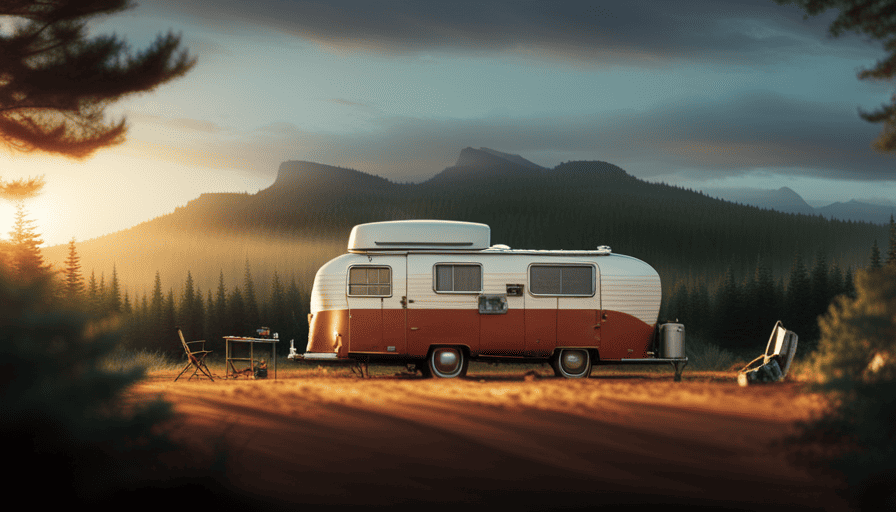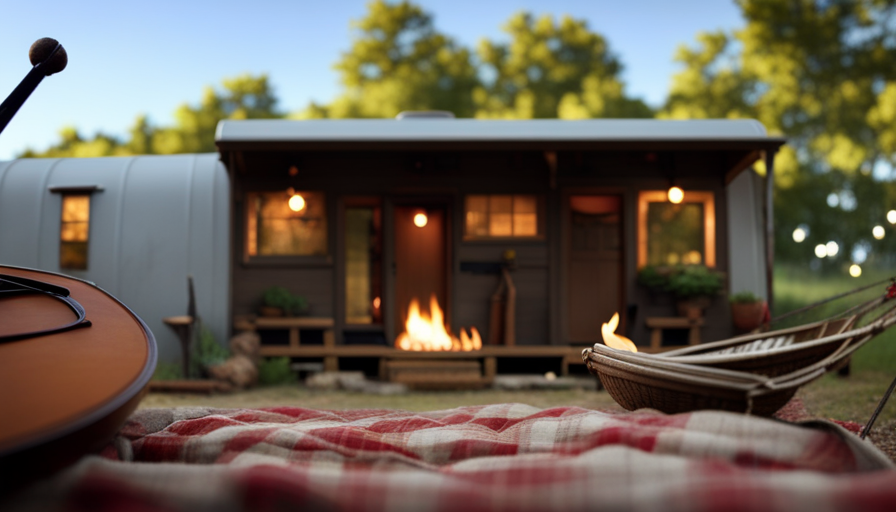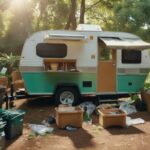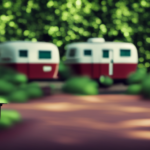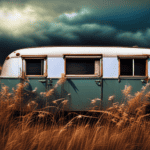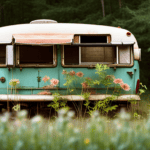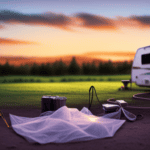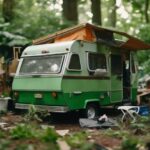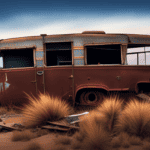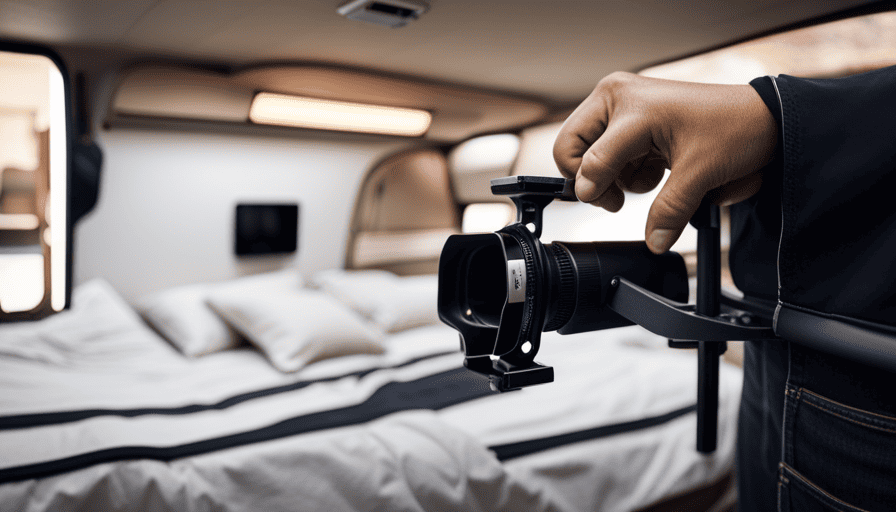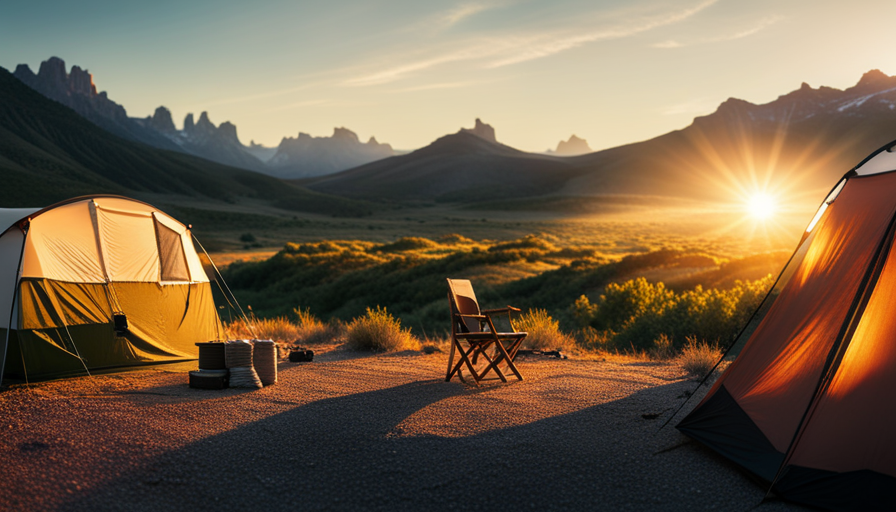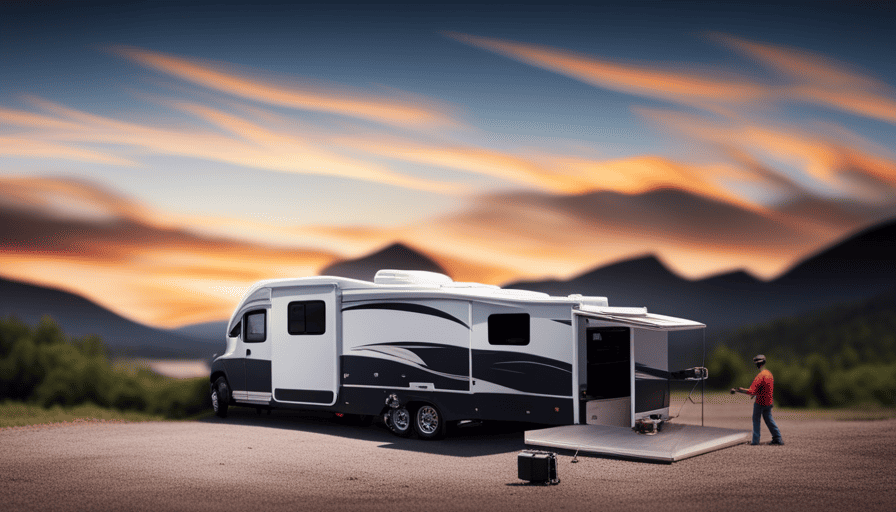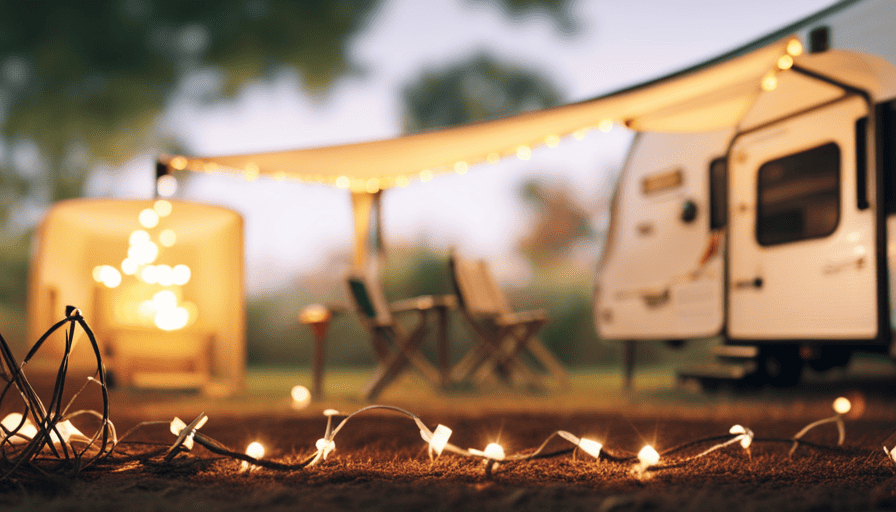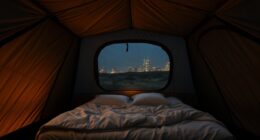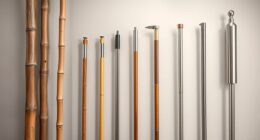Did you know that there are over 11 million recreational vehicles (RVs) on the roads in the United States? With such a large number, many people eventually need to dispose of their old campers. Whether you’ve upgraded to a newer model or simply no longer need your camper, it’s important to know the proper way to dispose of it.
In this article, I will guide you through the process of disposing of your old camper in a thorough and knowledgeable manner. From assessing its condition to exploring recycling options, trade-ins, and local removal services, I will provide you with all the information you need to make an informed decision.
So, let’s dive in and ensure that your old camper finds a new home in the most responsible and efficient way possible.
Key Takeaways
- Assess the condition of the camper before deciding how to dispose of it, considering factors such as water damage, structural issues, and the condition of appliances, plumbing, and electrical systems.
- Research potential buyers or organizations for selling or donating the camper, and clean and declutter it before listing it for sale or donation.
- Explore recycling options such as local recycling centers, scrap yards, RV salvage yards, online platforms, or donation to non-profit groups, as recycling old campers is an environmentally friendly option that supports a sustainable future.
- Consider trade-in options by contacting dealerships or RV manufacturers, inquiring about trade-in programs, and negotiating the trade-in value based on the camper’s condition and features.
Assess the condition of your camper
Before you can decide how to dispose of your old camper, you should assess its condition and determine if it can be salvaged or repurposed. Assessing the value of your camper is an important step in this process.
Take a close look at the overall condition of the camper, both inside and out. Check for any signs of water damage, such as soft spots on the floor or walls, as well as any structural issues. Evaluate the condition of the appliances, plumbing, and electrical systems to see if they’re in working order.
Next, consider the repairs that the camper may need. Are there any major issues that would require extensive and costly repairs? Take into account the cost of these repairs compared to the value of the camper. If the repairs outweigh the value, it may not be worth salvaging.
Once you have assessed the condition and evaluated the repairs needed, you can determine if the camper can be sold or donated. If the camper is in good condition and only needs minor repairs, it may be worth selling to someone who’s willing to fix it up. On the other hand, if the camper is beyond repair or not worth salvaging, donating it to a charitable organization or recycling it may be the best option.
Determine if it can be sold or donated
When determining if my old camper can be sold or donated, I research potential buyers or organizations that may be interested in acquiring it. I take the time to thoroughly investigate different options and gather information on local camper dealerships, online marketplaces, and charitable organizations that accept camper donations.
Once I’ve identified potential buyers or organizations, I prepare the camper for sale or donation by thoroughly cleaning and organizing it, ensuring that all systems are functioning properly, and gathering any necessary paperwork or documentation.
Research potential buyers or organizations
To find a potential buyer or organization for your old camper, start by researching online platforms like Craigslist or Facebook Marketplace. These platforms have a staggering 80% success rate for people selling their used RVs and finding interested buyers. You can post detailed descriptions, include multiple photos, and even negotiate the price directly with potential buyers.
Additionally, you can explore specialized websites that cater specifically to RV sales, such as RV Trader or RVT.com. These websites attract a targeted audience of RV enthusiasts who are more likely to be interested in purchasing your camper.
Another option is to reach out to local RV dealerships or consignment shops. They may be interested in selling your camper on your behalf.
By exploring these potential buyers and organizations, you can increase your chances of finding a suitable home for your old camper.
Now, let’s move on to preparing the camper for sale or donation.
Prepare the camper for sale or donation
Now, let’s get the camper ready for selling or donating to its new owner. Before listing it for sale or exploring donation options, it’s important to prepare the camper to maximize its value. Here are a few steps to consider:
-
Clean and declutter: Give the camper a thorough cleaning, inside and out. Remove personal belongings and any unnecessary items to make it more attractive to potential buyers or organizations.
-
Make necessary repairs: Fix any minor issues or damages to ensure the camper is in good working condition. Replace any broken appliances or fixtures to enhance its appeal.
-
Advertise effectively: Take high-quality photos of the camper and create a compelling listing. Highlight its features and include relevant details to attract potential buyers. Utilize online marketplaces, social media, and local classifieds to reach a wider audience.
-
Set a reasonable price: Research similar campers in the market to determine a fair asking price. Consider factors like age, condition, and current demand.
With the camper ready for sale or donation, it’s time to consider recycling options for any remaining materials.
Consider recycling options
If you’re looking to make a positive impact on the environment, recycling your old camper is a great option. Not only is it an environmentally friendly disposal method, but it also allows you to contribute to the circular economy by giving new life to the materials in your camper. Recycling options for old campers vary depending on your location, but here are some common options to consider:
| Recycling Option | Description | Benefits |
|---|---|---|
| Local Recycling Centers | Many cities and towns have recycling centers | Reduces landfill waste and promotes recycling |
| Scrap Yards | Scrap yards can dismantle and recycle campers | Salvages valuable materials for reuse |
| RV Salvage Yards | Specialized yards that recycle RV parts | Allows for reuse of specific RV components |
| Online Platforms | Websites like Craigslist or eBay | Gives your camper a chance for a second life |
| Donation to Non-Profit Groups | Organizations that accept campers as donations | Provides resources for those in need |
By recycling your old camper, you are helping to minimize waste and support a more sustainable future. Once you have considered recycling options, the next step is to explore trade-in options for your old camper.
Explore trade-in options
When exploring trade-in options for my old camper, I would first reach out to various dealerships or RV manufacturers to inquire about their trade-in programs. This way, I can get a better understanding of what options are available to me and what kind of value I can expect to receive.
Once I have gathered all the necessary information, I can then negotiate the trade-in value based on the condition and features of my camper. By being thorough and knowledgeable about the trade-in process, I can ensure that I’m getting the best possible value for my old camper.
Contact dealerships or RV manufacturers
First things first, you should reach out to local dealerships or RV manufacturers to explore your options for disposing of your old camper. Many dealerships have RV dealer partnerships that allow them to take in old campers for trade-in or sale. They may have specific programs in place to help you get rid of your old camper responsibly.
Additionally, some RV manufacturers have recycling programs where they accept old campers and recycle their parts or materials. By contacting dealerships or RV manufacturers, you can find out if they have any trade-in or recycling options available for your old camper.
Once you have explored these possibilities, you can then negotiate the trade-in value for your camper. This will ensure that you get the best deal possible when it comes to disposing of your old camper and potentially purchasing a new one.
Negotiate the trade-in value
To get the best deal when trading in your camper, negotiate the value with dealerships or manufacturers. Trade-in negotiations can be a crucial step in determining the value of your old camper. Here are some key points to consider during the negotiation process:
-
Research the market value of your camper beforehand, so you have a baseline for negotiations.
-
Highlight any unique features or recent upgrades that may increase its value.
-
Be prepared to negotiate and counteroffer if the initial trade-in value is lower than your expectations.
-
Consider getting quotes from multiple dealerships or manufacturers to compare offers and leverage them against each other.
By engaging in trade-in negotiations, you can ensure that you receive a fair value for your old camper. Once you have completed this step, you can move on to the next section about advertising for free or low-cost disposal, expanding your options for finding a new owner for your camper.
Advertise for free or low-cost disposal
Consider posting an ad online or in your local community to find someone in need of a camper, as there are approximately 40 million online classified ads posted each month. This can be an effective way to advertise your camper for free or at a low cost. In the ad, be sure to mention that you’re looking for someone to take the camper off your hands for free or at a minimal cost. Highlight any unique features or benefits of the camper to attract potential buyers.
When advertising for free or low-cost disposal, it’s important to provide clear and detailed information about the camper. Include the make, model, year, and any additional features or amenities. Take quality photos from different angles to give potential buyers a good idea of what they’re getting. Be honest about the condition of the camper and if there are any repairs that need to be made.
In addition to online ads, consider reaching out to local community groups or organizations that may be interested in your camper. You can post on social media platforms, community bulletin boards, or even ask friends and family if they know anyone who may be interested. By utilizing these free or low-cost disposal options, you increase the chances of finding someone who’ll take your old camper off your hands.
Transitioning into the next section, another option to consider is seeking out salvage yards or scrap metal buyers. These entities may be interested in purchasing your camper for its parts or for the scrap metal value.
Seek out salvage yards or scrap metal buyers
After considering the option to advertise for free or low-cost disposal of your old camper, it might be worth exploring salvage yards or scrap metal buyers as an alternative solution. This route involves selling your camper to a salvage yard or scrap metal buyer who will dismantle it and recycle the materials.
One advantage of this approach is that salvage yards and scrap metal buyers are often willing to pay for old campers, even if they’re no longer in working condition. This means you can potentially recoup some of the costs associated with disposing of your camper.
Additionally, by choosing this route, you can ensure that the materials from your old camper are being recycled and repurposed rather than ending up in a landfill.
When considering salvage yards or scrap metal buyers, it’s important to do some research to find reputable businesses in your area. Look for companies that specialize in scrap metal recycling and have experience handling campers or RVs. You can contact them to inquire about their purchasing process and any specific requirements they may have.
Exploring salvage yards or scrap metal buyers can be a viable option for disposing of your old camper while also potentially receiving some compensation. However, if this option doesn’t suit your needs, the next step is to contact local RV or camper removal services.
Contact local RV or camper removal services
If salvage yards or scrap metal buyers aren’t the right fit for you, reach out to local RV or camper removal services for assistance with getting rid of your unwanted vehicle. RV removal services specialize in removing and disposing of old campers, ensuring that the process is seamless and hassle-free for you. They have the necessary equipment and expertise to safely and efficiently remove your camper from your property.
When it comes to disposing of your old camper, you may be wondering whether to sell or donate it. Selling your camper can help you recoup some of the costs, especially if it’s still in good condition. You can list it online or advertise locally to find potential buyers. On the other hand, donating your camper can be a great option if you’re looking to do some good and help others. There are organizations and charities that accept camper donations and use them for various purposes, such as providing shelter for the homeless or supporting disaster relief efforts.
Consider repurposing or upcycling options for your old camper, as there are many creative ways to give it a new life. Some people transform old campers into guest houses, mobile offices, or even tiny homes. By repurposing or upcycling your camper, you not only reduce waste but also create something unique and functional.
Moving on to the next section about ‘consider repurposing or upcycling options’, there are several exciting possibilities to explore.
Consider repurposing or upcycling options
When it comes to disposing of an old camper, one option to consider is repurposing or upcycling. There are plenty of DIY projects and creative ideas out there that can give new life to your old camper.
From turning it into a backyard office or guest room to transforming it into a mobile food truck or tiny home, the possibilities are endless.
Additionally, you can also try reaching out to local organizations or individuals who may be interested in repurposing your camper for their own use.
Explore DIY projects or creative ideas for repurposing
Get inspired and discover all the amazing DIY projects and creative ideas you can explore to repurpose your old camper!
Here are some exciting ways to repurpose furniture and create unique DIY home decor pieces:
-
Convert the camper into a cozy reading nook by adding a comfortable seating area with cushions and shelves for books.
-
Transform the camper into a mobile mini bar, complete with a countertop, shelves for bottles, and space for glassware.
-
Repurpose the camper into a backyard playhouse for kids, with a small slide, swings, and a mini picnic table.
-
Turn the camper into a stylish guest room by adding a comfortable bed, curtains for privacy, and storage space for clothes.
By repurposing your old camper in these creative ways, you can give it a new lease on life while adding unique and functional pieces to your home. Once you’ve explored these DIY projects, it’s time to find local organizations or individuals interested in repurposing to continue the journey of giving new life to your old camper.
Find local organizations or individuals interested in repurposing
Contrary to popular belief, there are countless local organizations and individuals who are eager to breathe new life into your beloved camper by repurposing it. Collaborative initiatives between these organizations and individuals have been formed to promote sustainability and reduce waste. By repurposing old campers, not only are you giving them a second chance, but you are also contributing to the environmental benefits of recycling and reducing landfill waste.
To give you an idea of the possibilities, here is a table showcasing some creative repurposing ideas for old campers:
| Repurposing Idea | Description | Potential Use |
|---|---|---|
| Mobile Workspaces | Transform your old camper into a mobile workshop | Artists, craftsmen, or entrepreneurs |
| Tiny Homes | Convert the camper into a cozy living space | Minimalists or those seeking simplicity |
| Mobile Stores | Create a mobile boutique or food truck | Small business owners or entrepreneurs |
With these collaborative initiatives and the environmental benefits in mind, it’s clear that repurposing your old camper can be a win-win situation. However, before you can repurpose it, you’ll need to properly clean and prepare the camper for disposal.
Properly clean and prepare the camper for disposal
Before disposing of my old camper, I made sure to remove all personal belongings and thoroughly clean the interior. This included emptying out cabinets and drawers, vacuuming and wiping down surfaces, and removing any stains or odors.
Additionally, I took the necessary steps to dispose of any waste or hazardous materials properly, such as emptying and cleaning the holding tanks and safely disposing of any chemicals or fuel.
By taking these precautions, I ensured that the camper was in its best possible condition for disposal and minimized any potential harm to the environment.
Remove personal belongings and clean the interior
First, take a moment to envision yourself carefully sorting through your personal belongings, gently removing each item from its place in the well-loved camper. As you go through the camper, think about potential repurposing ideas for items that hold sentimental value or could be useful in a different way.
For example, old curtains could be turned into pillows or reused for a DIY project. Once all personal items have been removed, it’s time to deep clean the interior. Use appropriate cleaning techniques, such as vacuuming the upholstery, wiping down surfaces with disinfectant, and cleaning the windows with glass cleaner. Pay special attention to any stains or odors, using appropriate products to remove them.
With the interior clean and belongings sorted, you are now ready to dispose of any waste or hazardous materials in an environmentally responsible manner. Remember to follow local regulations and dispose of these materials safely.
Transitioning into the subsequent section, it’s important to address the proper disposal of waste and hazardous materials without causing harm to the environment.
Dispose of any waste or hazardous materials
Now it’s time to get rid of any waste or hazardous materials in a responsible manner, ensuring the safety of the environment. When disposing of waste from your old camper, it’s important to follow proper waste management procedures to minimize the environmental impact.
Here are two sub-lists to guide you through the process:
-
General waste disposal:
- Empty all trash cans and remove any loose items.
- Separate recyclable items such as plastic bottles, aluminum cans, and cardboard boxes for recycling.
-
Hazardous materials disposal:
- Identify and remove any hazardous materials, such as batteries, propane tanks, and cleaning chemicals.
- Contact your local waste management facility for instructions on how to properly dispose of these items.
Properly disposing of waste and hazardous materials is crucial to protect the environment from pollution and harm. Once you’ve completed this step, you can move on to documenting the disposal process in the subsequent section about ‘documenting the disposal process’.
Document the disposal process
When it comes to disposing of an old camper, it’s crucial to document the disposal process. I keep records of any transactions or agreements made during the disposal, ensuring that all parties involved are accounted for.
Additionally, proper documentation for the legal disposal or transfer of ownership is essential to avoid any potential issues down the line. By meticulously documenting the disposal process, I can ensure a smooth and hassle-free transition for both myself and the new owner.
Keep records of any transactions or agreements
To properly bid farewell to your beloved camper, make sure to hold on tightly to any records of transactions or agreements as if they’re the compass guiding you through uncharted waters.
Keeping records of any transactions or agreements is crucial when disposing of an old camper. It not only helps you stay organized but also provides a legal trail of the camper’s ownership transfer. To ensure proper documentation for the legal disposal or transfer of ownership of your old camper, consider the following:
- Keep a copy of the bill of sale or any purchase agreements.
- Maintain a record of any repairs or modifications made to the camper.
- Save receipts for any parts or accessories purchased.
- Document any communication or agreements with potential buyers or disposal services.
By diligently keeping these records, you can navigate the process smoothly and ensure a seamless transfer of ownership or disposal of your old camper.
Now, let’s delve into the next section on how to ensure proper documentation for legal disposal or transfer of ownership.
Ensure proper documentation for legal disposal or transfer of ownership
Make sure you have all the necessary paperwork in order to smoothly transfer ownership or legally dispose of your cherished camper. When it comes to the legal disposal or transfer of ownership of your old camper, it’s crucial to ensure proper documentation.
First and foremost, familiarize yourself with the legal requirements in your jurisdiction regarding the disposal or transfer of ownership of vehicles. This may include obtaining a title transfer form, bill of sale, or other relevant documents. Failure to comply with these requirements can result in potential legal issues down the line.
Additionally, if you’re transferring ownership to another party, it’s important to draft a written agreement that clearly outlines the terms and conditions of the transfer. This will help protect both parties involved and prevent any misunderstandings or disputes in the future.
By discussing the legal requirements and potential legal issues, you can ensure a smooth and hassle-free disposal or transfer of ownership process.
Frequently Asked Questions
Can I donate my old camper to a charity or non-profit organization?
Absolutely! Donating your old camper to a charity or non-profit organization is a fantastic option. Not only will you be helping a worthy cause, but you may also be eligible for valuable tax deductions.
Many organizations gladly accept camper donations and use them for various purposes, such as providing shelter for the homeless or offering recreational programs for underprivileged individuals.
It’s a win-win situation that allows you to make a positive impact while enjoying potential financial benefits.
Are there any regulations or restrictions on recycling camper materials?
There are indeed regulations and restrictions in place when it comes to recycling camper materials. These regulations aim to minimize the environmental impact caused by the disposal of old campers.
Materials such as batteries, propane tanks, and hazardous chemicals must be properly disposed of according to local regulations. Additionally, certain materials like fiberglass and aluminum can be recycled, but it’s important to check with local recycling facilities to ensure they accept these materials.
Properly recycling camper materials helps protect the environment and ensures compliance with regulations.
How do I find out if there are any trade-in options available for my old camper?
If you’re looking for trade-in options or selling options for your old camper, there are a few steps you can take to find out.
Start by researching local dealerships or RV retailers that offer trade-in services. Contact them directly to inquire about their trade-in policies and if they accept campers.
Additionally, you can explore online platforms or classified ads specifically for RV sales, where you can list your camper for potential buyers.
Remember to gather all relevant information about your camper to ensure a smooth transaction.
Are there any specific steps I need to take to properly clean and prepare my camper for disposal?
To ensure proper disposal of my old camper, it’s essential to follow a thorough cleaning process and adhere to proper disposal methods.
Firstly, I’d start by removing all personal belongings and cleaning out any debris or trash.
Next, I’d thoroughly clean the interior, including the floors, walls, and appliances, using appropriate cleaning products.
Lastly, I’d clean the exterior, paying special attention to any stains or rust.
By following these steps, I can ensure that my camper is ready for proper disposal.
What are some examples of repurposing or upcycling options for old campers?
Upcycling old campers can be like giving them a second chance at life. There are countless repurposing ideas to transform them into unique and functional spaces.
Some popular options include turning them into guest houses, mobile offices, or even tiny homes. With a little creativity and DIY skills, you can create a cozy and stylish living space while reducing waste.
The possibilities are endless when it comes to repurposing old campers!
Can a Clogged Camper Black Tank Affect Proper Disposal of an Old Camper?
Yes, a clogged camper black tank can definitely affect the proper disposal of an old camper. It can lead to unpleasant odors, leakage, and potential damage to the camper. To avoid these issues, it’s important to regularly unclog camper black tank and properly maintain the tank to ensure smooth disposal.
Conclusion
After exploring all the options for disposing of my old camper, I’ve come to a surprising conclusion. It turns out that my camper can be repurposed into something completely new and unique with a little bit of love and creativity. The possibilities are endless – a tiny home, a mobile office, or even a backyard guest house. It’s incredible to think that what was once considered junk can now have a second life. So before you say goodbye to your old camper, take a moment to think about the endless possibilities that await.

